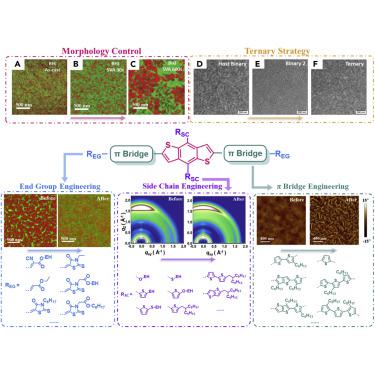Matter ( IF 17.3 ) Pub Date : 2020-11-04 , DOI: 10.1016/j.matt.2020.09.001 Hua Tang , Cenqi Yan , Jiaming Huang , Zhipeng Kan , Zeyun Xiao , Kuan Sun , Gang Li , Shirong Lu

|
Organic solar cells (OSCs) have been considered being a promising candidate for next-generation photovoltaic technology because of their low carbon footprint, short energy payback time, and facile manufacture into lightweight, flexible, and semitransparent products. In this prosperous field, there is a rising trend of developing all-small-molecule (ASM) OSCs due to the distinct merits of small molecules, such as well-defined structures, facile purification, and pre-eminent batch-to-batch replicability, making it a preferential contender for industrialization. The majority of the best-performing ASM OSCs utilize benzodithiophene (BDT) donors, and recent breakthroughs demonstrate that this system has exceeded the 15% efficiency mark in the laboratory. This review analyzes the significant study that has led to this remarkable progress and focuses on the most effective BDT small-molecule donors. The pivotal structure-property relationships, donor-acceptor matching criteria, and morphology control approaches are discussed. Lastly, we summarize the remaining challenges and offer our perspective on the future advance of ASM OSCs.
中文翻译:

基于苯并二噻吩的小分子供体,用于下一代全小分子有机光伏
有机太阳能电池(OSC)由于其碳足迹低,能源回收期短以及易于制造为轻量,柔性和半透明产品而被认为是下一代光伏技术的有希望的候选者。在这个繁荣的领域,由于小分子的独特优点(如结构明确,纯化简便和批间重复性出色),发展全小分子(ASM)OSC的趋势呈上升趋势使其成为工业化的优先竞争者。大多数性能最佳的ASM OSC使用苯并二噻吩(BDT)供体,最近的突破表明该系统已超过实验室效率的15%。这篇综述分析了导致这一显着进展的重要研究,并将重点放在了最有效的BDT小分子供体上。讨论了关键的结构-属性关系,供体-受体匹配标准和形态控制方法。最后,我们总结了尚待解决的挑战,并对ASM OSC的未来发展提出了自己的看法。











































 京公网安备 11010802027423号
京公网安备 11010802027423号